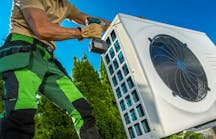An effective and affordable way to reduce radon levels in homes using side wall venting is now available from Tjernlund Products, Inc., the originator and leading manufacturer of side wall vent systems for gas and oil fueled heaters. Called Radon VACTTM, the proprietary system consists of a plug-in fan, exterior hood and installer-purchased PVC pipe. Because the Radon VACTTM side wall system evacuates through the basement side wall, homeowners can avoid having PVC pipe run vertically through living areas or outside of their homes to the roof line. A recent Health Canada study demonstrates that a side wall terminated radon mitigation system saves 57% in labor and 14% in material costs compared to a roof terminated system while yielding similar radon reduction levels.
Sources say the Radon VACTM system is engineered to reduce radon across a variety of sub-slab soil types. It features a sealed, galvanized fan housing and a PSC permanently lubricated, quiet, low watt motor. Unlike traditional radon fans the motor is not exposed to air stream moisture, increasing motor life.
The low profile, corrosion-proof Radon VACTM Variable Aspiration Control Hood dilutes the radon gas with fresh outdoor air as it exits the hood and safely propels it away from the structure. The dilution and velocity are easily adjustable at the hood to enhance the system's performance in high pressure drop applications.
Installation of the Radon VACTM system requires a four-inch hole through the home’s basement rim joist and exterior finish, plus enough three-inch PVC pipe to run from the radon extraction point to the Radon VACTM hood. The fan is typically installed between floor joists. A rubber isolating mounting bracket eliminates vibration transfer and rotates 360 degrees to accommodate any orientation.
Complete Radon VACTM information, including installation, performance and dimensions, is available at http://tjernlund.com or by calling 800-255-4208.










